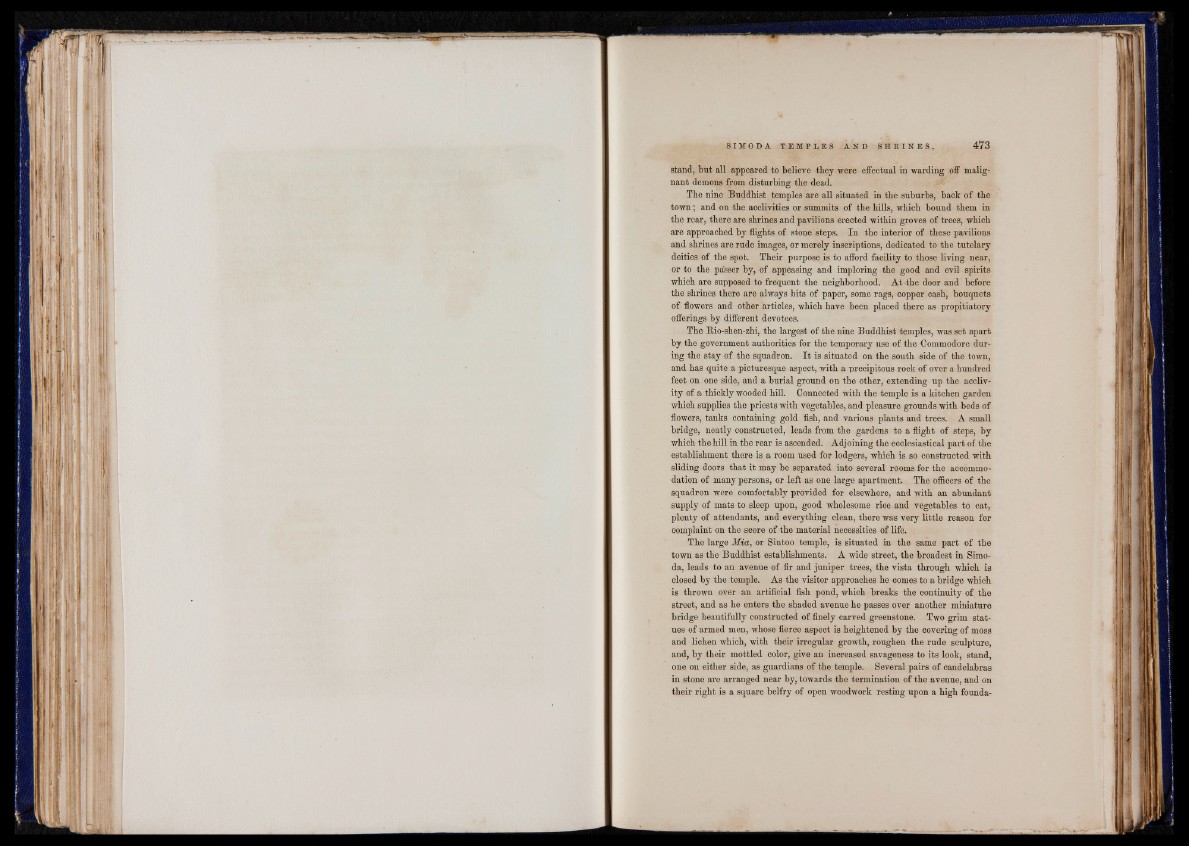
:
I » H
■
stand, but all appeared to believe they were effectual in warding off malignant
demons from disturbing the dead.
The nine Buddhist temples are all situated in the suburbs, back of the
town; and on the acclivities or summits of the hills, which bound them in
the rear, there are shrines and pavilions erected within groves of trees, which
are approached by flights of stone steps. In the interior of these pavilions
and shrines are rude images, or merely inscriptions, dedicated to the tutelary
deities of the spot. Their purpose is to afford facility to those living near,
or to the pa'sser by, of appeasing and imploring the good and evil spirits
which are supposed to frequent the neighborhood. At the door and before
the shrines there are always bits of paper, some rags, copper cash, bouquets
of flowers and other articles, which have been placed there as propitiatory
offerings by different devotees.
The Kio-shen-zhi, the largest of the nine Buddhist temples, was set apart
by the government authorities for the temporary use of the Commodore during
the stay of the squadron. I t is situated on the south side of the town,
and has quite a picturesque aspect, with a precipitous rock of over a hundred
feet on one side, and a burial ground on the other, extending up the acclivity
of a thickly wooded hill. Connected with the temple is a kitchen garden
which supplies the priests with vegetables, and pleasure grounds with beds of
flowers, tanks containing gold fish, and various plants and trees. A small
bridge, neatly constructed, leads from the gardens to a flight of steps, by
which the hill in the rear is ascended. Adjoining the ecclesiastical part of the
establishment there is a room used for lodgers, which is so constructed with
sliding doors that it may be separated into several rooms for the accommodation
of many persons, or left as one large apartment. The officers of the
squadron were comfortably provided for elsewhere, and with an abundant
supply of mats to sleep upon, good wholesome rice and vegetables to eat,
plenty of attendants, and everything clean, there was very little reason for
complaint on the score of the material necessities of life.
The large Mia, or Sintoo temple, is situated in the same part of the
town as the Buddhist establishments. A wide street, the broadest in Simo-
da, leads to an avenue of fir and juniper trees, the vista through which is
closed by the temple. As the visitor approaches he comes to a bridge which
is thrown over an artificial fish pond, which breaks the continuity of the
street, and as he enters the shaded avenue he passes over another miniature
bridge beautifully constructed of finely carved greenstone. Two grim statues
of armed men, whose fierce aspect is heightened by the covering of moss
and lichen which, with their irregular growth, roughen the rude sculpture,
and, by their mottled color, give an increased savageness to its look, stand,
one on either side, as guardians of the temple. Several pairs of candelabras
in stone are arranged near by, towards the termination of the avenue, and on
their right is a square belfry of open woodwork resting upon a high founda